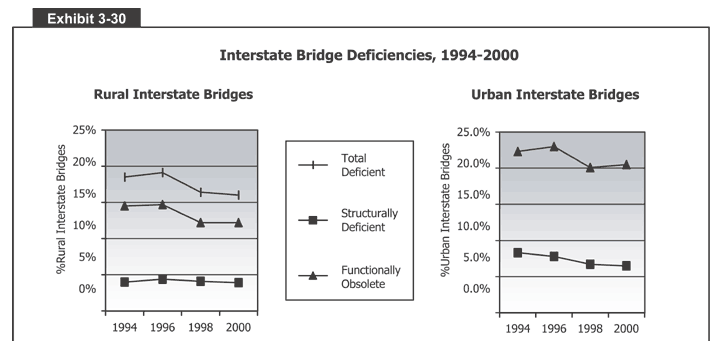U.S. Department of Transportation
Federal Highway Administration
1200 New Jersey Avenue, SE
Washington, DC 20590
202-366-4000
Conditions and Performance
Status
of the Nation's Highways, Bridges, and Transit:
2002 Conditions and Performance Report
|
Exhibit 3-30:
Interstate Bridge Deficiencies, 1994-2000
 Exhibit 3-30 includes two charts that show the percentage of deficient interstate bridges in rural and urban areas. The vertical axis on the chart on the left, for deficient rural interstate bridges, measures percentages of rural interstate bridges from 0 to 25 in increments of 5 percent. The horizontal axis measures the years 1994, 1996, 1998, and 2000. Functionally obsolete rural interstate bridges stayed at about 4 percent over the time period. Structurally deficient rural interstate bridges declined from 15 percent in 1994 and 1996 to about 12 percent in 1998 and 2000. And the total percentage of deficient rural interstate bridges declined steadily from about 18 percent in 1994 and 1996 to about 16 percent in 1998 and 2000. The vertical axis on the chart on the right, for deficient urban interstate bridges, also measures percentages of urban interstate bridges from 0 to 25 in increments of 5 percent, and the horizontal axis also measures the years 1994, 1996, 1998, and 2000. Functionally obsolete urban interstate bridges went from about 22 percent in 1994 to 23 percent in 1996, then to 20 percent in 1998 and 2000. Structurally deficient urban interstate bridges declined steadily from about 8 percent in 1994 to 6 percent in 2000. No line is given to represent the total percentage of deficient urban interstate bridges from 1994 to 2000.
Back
to Chapter 3
Exhibit 3-30 includes two charts that show the percentage of deficient interstate bridges in rural and urban areas. The vertical axis on the chart on the left, for deficient rural interstate bridges, measures percentages of rural interstate bridges from 0 to 25 in increments of 5 percent. The horizontal axis measures the years 1994, 1996, 1998, and 2000. Functionally obsolete rural interstate bridges stayed at about 4 percent over the time period. Structurally deficient rural interstate bridges declined from 15 percent in 1994 and 1996 to about 12 percent in 1998 and 2000. And the total percentage of deficient rural interstate bridges declined steadily from about 18 percent in 1994 and 1996 to about 16 percent in 1998 and 2000. The vertical axis on the chart on the right, for deficient urban interstate bridges, also measures percentages of urban interstate bridges from 0 to 25 in increments of 5 percent, and the horizontal axis also measures the years 1994, 1996, 1998, and 2000. Functionally obsolete urban interstate bridges went from about 22 percent in 1994 to 23 percent in 1996, then to 20 percent in 1998 and 2000. Structurally deficient urban interstate bridges declined steadily from about 8 percent in 1994 to 6 percent in 2000. No line is given to represent the total percentage of deficient urban interstate bridges from 1994 to 2000.
Back
to Chapter 3
Return to top
Page last modified on November 7, 2014
